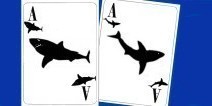|

Join our Newsletter
& get our free guide Starting Hands Revealed
We hate spam too!
We value your privacy and never share your email. All our emails have an opt-out link. Click it, and you will never hear from us again. 

|
3-betting light
Nowadays, the prevalent strategy in middle to high stake full ring cash games is TAG, with VPIP/PFR around 15/12. This is considered to be an optimal level of a player's statistics, any lower numbers viewed as nit and any higher numbers regarded as lag-spew. At low and micro-stakes, these statistics are much broader with more maniacs and fish and some rocks, but such a TAG style is nevertheless considered a good starting point. At 6-max overall play is looser but the general idea of this article is the same. Make sure to use an advanced HUD such as poker-edge if you want to instantly know your opponents' styles. The problem with the prevalent TAG strategy is that the corresponding preflop 3-betting frequency is around 2-3%, which is equivalent to a range {KK+,AK} or sometimes {QQ+,AK} in full ring games. This makes the TAG style very predictable in case of a 3-bet, which is associated with such a narrow range. 3-betting light is a way to nullify that predictability and gain control by 3-betting preflop with a much wider range. Say for example in a $2/$4 no-limit Texas Hold'em game that I played at FullTilt Poker, everyone folds to the button (average TAG) who raises to $12, the small blind folds, the big blind holds 9♣ 8♣ and 3-bet to $40. As the stealing range from the button is so wide even from a medium TAGfish, this stealing range is beaten by {KK+,AK}. Henceforth, given the strength expressed by the big blind who has the burden to be out of position, it is a mandatory fold for the button, who held A♣ J♥ in this example, turning out to be the stronger hand with 59% pot equity. Like for anything else in poker, there is always the upside and the downside. The downside of this poker strategy is that if the button decides to call, the big blind has already invested $40 and 9♣8♣ is a difficult hand to play, especially out of position. If the button had KK and 4-bet, i.e. reraised with an even higher wager, the big blind must fold as he only has 22% pot equity and no fold equity. For simplicity if the two possible scenarios are that one player folds preflop, then the big blind risks $36 in order to make $18, so he must force the button to fold at least 66% of the time on average. This is not unreasonable if done infrequently and at well-timed opportunities. But there are other benefits of 3-betting light beyond the possibility of a direct fold. If the flop comes something like K♥8♠4♦, a standard continuation bet may force a fold if it did not hit the villain strongly. So 3-betting is usually more effective against late position players who will raise preflop with weaker hole cards. Also 3-betting with suited connectors, low pairs or middle aces gives the opportunity to hit big with an unexpected holding which may deliver the entire stack of your deceived opponent on a platter. Another benefit is to project the image of a maniac, which will induce a lot of action in the future. If the 3-bettor makes a continuation bet and the hand goes to a showdown, showing next to nothing, this will give him a crazy image, which he can leverage off later when he 3-bets with a strong hand and his large bets are called by unbelievers. In summary, "3-betting light" must belong to the arsenal of any good hold'em player, but it should be used wisely, taking into account position, players' styles, table dynamics, opponents' range for calling 3-bets if known and your current table image. Use 3-betting light preflop parsimoniously, otherwise your opponents will rapidly notice your bluffs and you will have to answer to their 4-betting light.
|












